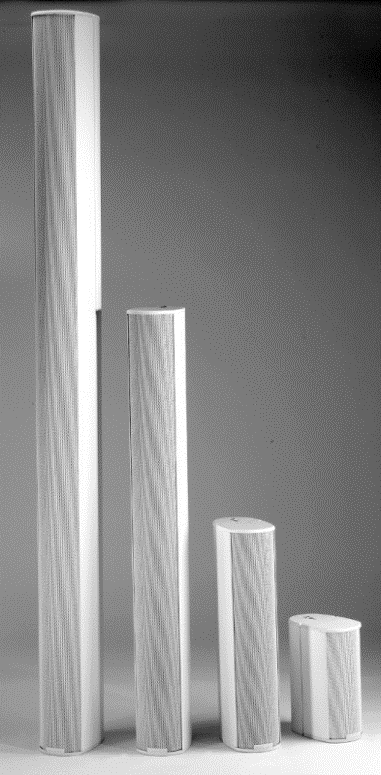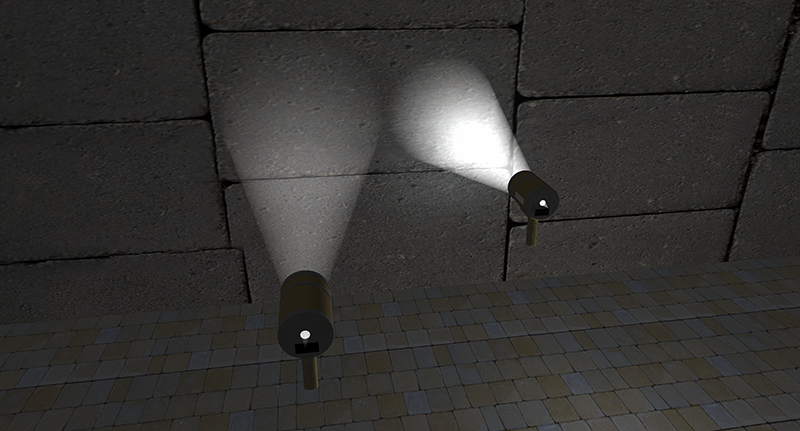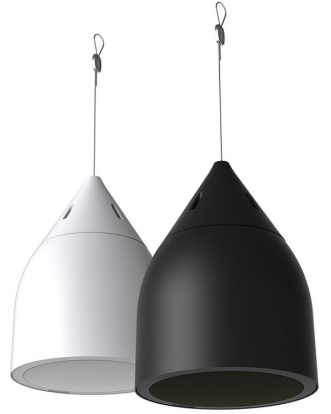
A high-directivity loudspeaker is typically large in size for a point source type, or tall if it is a column loudspeaker. Some examples of column loudspeakers can be noted in Figure 13. If the reader observes carefully figure 11, bottom right picture, most of the ceiling areas are not red. The high directivity column loudspeakers are focusing sound toward the audience area, not spraying too much sound everywhere else. With a high directivity loudspeaker, the amount of sound reflections can be reduced, resulting in less ‘room sound’. Unlike in the visual world where reflections can be beautiful, in sound system world we want to deliver most of the loudspeaker’s direct sound to the audience, not to the ceiling.

Returning to the light analogy in Figures 8 – 10, the light bulb represents a low-directivity point source loudspeaker and the spotlight represents a high directivity loudspeaker. We strongly urge the help of a sound system/acoustical consultant to deal with a difficult reverberant room. If budget is very limited, one can contact a manufacture’s distributor/dealer to do in-situ demonstration of their loudspeakers. This will help to determine which loudspeaker types/models can support the functionality of the room.
More Complications
Sound system design and loudspeaker layout can get very complicated when the room is very reverberant/echoic (read: long reverberation time, typically longer than 2 seconds in the mid frequency range). Let us recall the light bulb analogy explanation: “Then a small bulb is turned on as illustrated in Figure 9. Can you read in this condition? Well, yes and no. When you get closer to the bulb, then it will aid the reading effort. However, if you are standing at the other far end of the room, reading may still not be possible.”
In general, the farther you are from the sound source, the more room sound you will receive. In other words, the level of the sound reflections (read: room sound) can be equal or stronger relative to the direct sound level at some distance away.

Figure 14 illustrates a flashlight where the light is creating a smaller but brighter cone when the distance is close to the wall, and a much bigger but less bright cone when the distance is far from the wall. With this analogy in mind, it’s important to note that a point source loudspeaker spreads more sound to wider area at a farther distance, hence the room sound can dominate. Room sound isn’t always bad, but the long decay time is typically detrimental to speech intelligibility.
This brings up another point that a shorter loudspeaker’s throw distance may be beneficial in a reverberant room. An extreme example will be the use of pendant-look loudspeaker for a long reverberant room such as a large Catholic church where the historical aesthetic restricts wall mounting of any kind of loudspeakers.

Pendant-look loudspeakers, such as shown in Figure 15, are typically point sources. Although they’re low directivity loudspeakers, a low mounting height can minimize the room sound excitation. Figure 16 illustrates such a system which is also appropriate for rooms with low ceiling height. This may require a professional installation but the total project cost may not be too high because pendant-look loudspeakers or in-ceiling loudspeakers are not too costly.

The caveat of this design is the coverage. Let us recall the flashlight analogy in figure 14. When a flashlight is close to the wall, the light cone is small but bright. So, to cover the wall area, more flashlights are needed at that same close distance. By having a short throw distance, a higher loudspeaker quantity is needed to achieve even coverage, but each loudspeaker does not need to run at high level (amplifiers can be less costly).
Conclusion
Sound system design gets complicated easily. Technical study/discussion is required if the readers are interested in knowing more. This short article only discusses common issues that are typically found in small-scale sound system deployment. Turning the volume knob to the right isn’t always ‘that’ simple and help from a sound system/acoustical consultant may be needed for a difficult room.
This article is inspired by many questions we received as a sound system/acoustical consultant, especially to help owners of small venues to step in the right direction. I would like to thank Pat Brown (www.ProSoundTraining.com) and Chris Devenney for their insights and for reviewing this article prior to publication, and also to William Ladson of Ladson Media for the illustrations.
